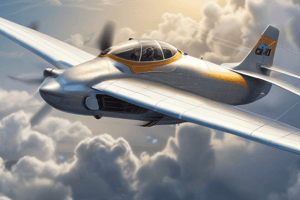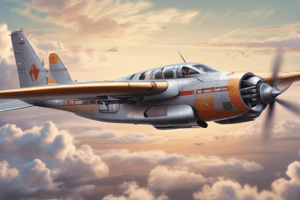Podcast
Questions and Answers
What is the effect of a critical engine inoperative on the power required and total drag?
What is the effect of a critical engine inoperative on the power required and total drag?
- Increases power required and total drag (correct)
- No effect on power required and total drag
- Increases power required and decreases total drag
- Decreases power required and total drag
How does a higher gross mass at the same altitude affect the gradient and rate of climb?
How does a higher gross mass at the same altitude affect the gradient and rate of climb?
- No effect on gradient and rate of climb
- Increases gradient and rate of climb
- Increases gradient and decreases rate of climb
- Decreases gradient and rate of climb (correct)
What is VX in relation to climb performance?
What is VX in relation to climb performance?
- Speed for best specific range
- Speed for best angle of flight path (correct)
- Speed for best angle of climb
- Speed for best rate of climb
Why does the take-off distance required increase?
Why does the take-off distance required increase?
What is the effect of a 75% power setting compared to a 65% power setting?
What is the effect of a 75% power setting compared to a 65% power setting?
What happens to the power required when an engine is inoperative?
What happens to the power required when an engine is inoperative?
What is the effect of a higher gross mass on VY and VX?
What is the effect of a higher gross mass on VY and VX?
What is the effect of headwind on take-off distance required?
What is the effect of headwind on take-off distance required?
What can limit the speed of a VMCL?
What can limit the speed of a VMCL?
What is the correct combination of statements that defines VMCA?
What is the correct combination of statements that defines VMCA?
Why is an MEP with inward counter-rotating propellers easier to control after an engine failure?
Why is an MEP with inward counter-rotating propellers easier to control after an engine failure?
What happens when an MEP with clockwise rotating propellers encounters a failure of the critical engine?
What happens when an MEP with clockwise rotating propellers encounters a failure of the critical engine?
What is the effect of an engine failure on an MEP with inward counter-rotating propellers?
What is the effect of an engine failure on an MEP with inward counter-rotating propellers?
What is the condition for VMCA to occur?
What is the condition for VMCA to occur?
What happens when a pilot suffers an engine failure and forgets to feather the propeller?
What happens when a pilot suffers an engine failure and forgets to feather the propeller?
What is the net flight path gradient after take-off compared to the actual climb gradient if the aeroplane is more than 50 ft above runway elevation?
What is the net flight path gradient after take-off compared to the actual climb gradient if the aeroplane is more than 50 ft above runway elevation?
What is the purpose of feathering a propeller in flight?
What is the purpose of feathering a propeller in flight?
What happens to the yawing effect when one of the engine's propellers are feathered on an MEP aircraft?
What happens to the yawing effect when one of the engine's propellers are feathered on an MEP aircraft?
What is the minimum VR speed for a Class B twin engine aeroplane according to CS23?
What is the minimum VR speed for a Class B twin engine aeroplane according to CS23?
When are the blades of a propeller in the feathered position?
When are the blades of a propeller in the feathered position?
Which engine is critical in a twin engine turbo prop with two clockwise props?
Which engine is critical in a twin engine turbo prop with two clockwise props?
What is the effect of not feathering a propeller during an engine failure?
What is the effect of not feathering a propeller during an engine failure?
Which of the following statements about asymmetric effects of the propeller slipstream are correct during an engine failure of a twin-engine turboprop airplane?
Which of the following statements about asymmetric effects of the propeller slipstream are correct during an engine failure of a twin-engine turboprop airplane?
What are the effects of feathering a propeller in flight?
What are the effects of feathering a propeller in flight?
Which condition will result in the least asymmetric yaw and roll in case of an engine failure in a twin-engine propeller airplane?
Which condition will result in the least asymmetric yaw and roll in case of an engine failure in a twin-engine propeller airplane?
What will happen to the rolling moment if the right engine fails in a twin engine turbo prop with two clockwise props?
What will happen to the rolling moment if the right engine fails in a twin engine turbo prop with two clockwise props?
What determines the stall speeds of an aircraft?
What determines the stall speeds of an aircraft?
What determines the minimum control speeds of an aircraft?
What determines the minimum control speeds of an aircraft?
What will happen to the slipstream-induced lift if the left engine fails in a twin-engine turboprop airplane?
What will happen to the slipstream-induced lift if the left engine fails in a twin-engine turboprop airplane?
What is the main factor that affects the net flight path gradient after take-off?
What is the main factor that affects the net flight path gradient after take-off?
What is the minimum control speed in the landing configuration?
What is the minimum control speed in the landing configuration?
What is the primary factor that limits VMCL?
What is the primary factor that limits VMCL?
What is the primary purpose of determining VMCG?
What is the primary purpose of determining VMCG?
What is the effect of crosswind on VMCG?
What is the effect of crosswind on VMCG?
What is the primary factor that affects VMCA?
What is the primary factor that affects VMCA?
What is the condition for establishing minimum control speeds during flight tests?
What is the condition for establishing minimum control speeds during flight tests?
What must the thrust be in a straight steady climb?
What must the thrust be in a straight steady climb?
What is the primary purpose of determining minimum control speeds?
What is the primary purpose of determining minimum control speeds?
Flashcards are hidden until you start studying
Study Notes
Critical Engine Inoperative
- Inoperative engine increases power required and total drag due to windmilling engine and yaw moment compensation.
- Higher gross mass at same altitude decreases gradient and rate of climb.
Performance
- VX: speed for best angle of flight path.
- VY: speed for best rate of climb.
Take-Off Distance
- Increases due to higher gross mass, downhill slope, slush on runway, and headwind.
Cruise Power Settings
- 75% power setting increases speed, fuel consumption, and fuel-burn/distance compared to 65% power setting.
Net Flight Path Gradient
- Net flight path gradient after take-off is smaller than actual climb gradient.
VR Speed for Class B Twin Engine Aeroplane
- Minimum VR speed is 90 kts according to CS23.
Critical Engine
- Critical engine for twin-engine turbo prop with two clockwise props is the right engine.
Asymmetric Effects of Propeller Slipstream
- Rolling moment towards the running engine is induced.
- Slipstream-induced lift is lost on the side where the engine has failed.
Engine Failure
- Yawing effect reduces when one engine's propeller is feathered on an MEP aircraft.
Stall Speeds and Minimum Control Speeds
- Stall speeds are determined with CG at forward limit.
- Minimum control speeds are determined with CG at aft limit.
Minimum Control Speeds
- VMCL is the minimum control speed in the landing configuration.
- VMCA is the minimum speed at which directional control can be maintained after engine failure.
Straight Steady Climb
- Thrust must be greater than drag in a straight steady climb.
Studying That Suits You
Use AI to generate personalized quizzes and flashcards to suit your learning preferences.




